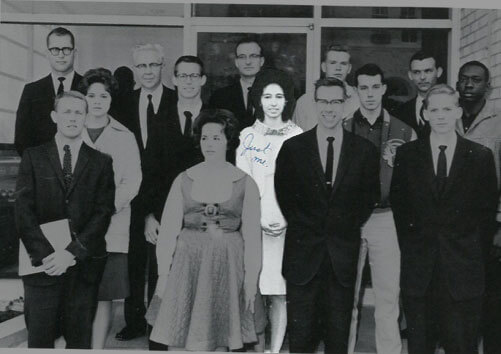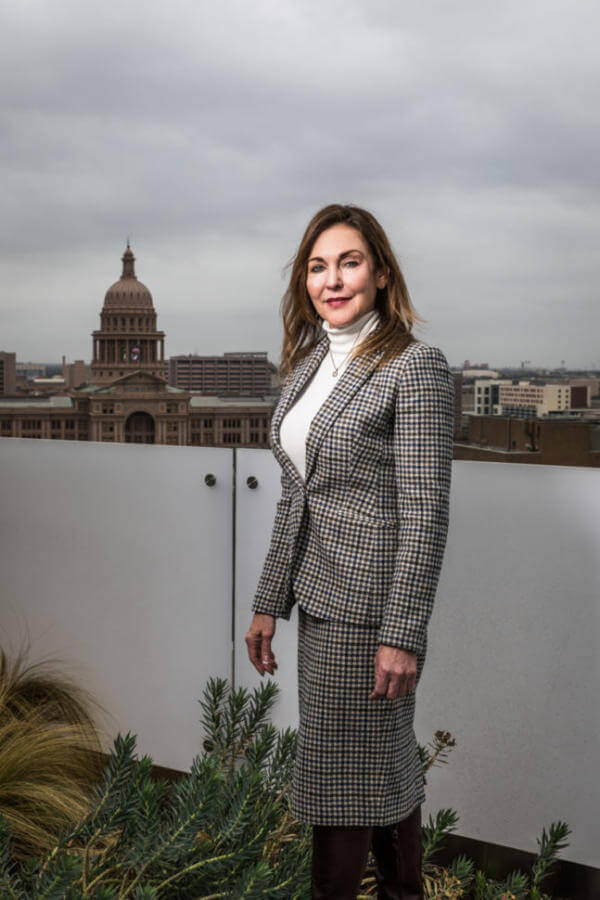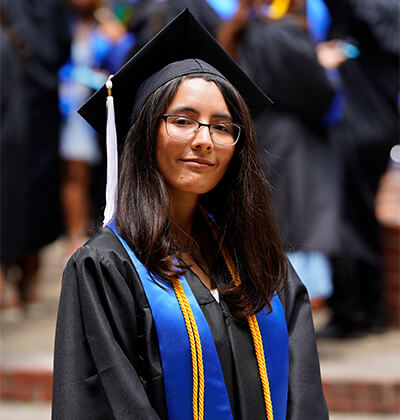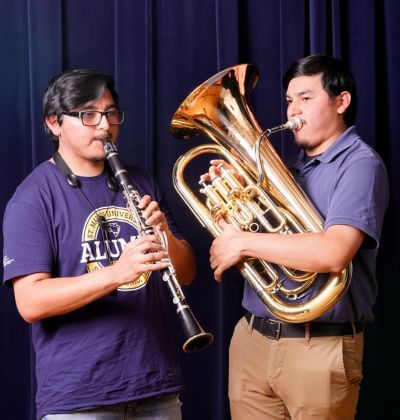by Jennifer R. Lloyd (M.B.A. ’16)
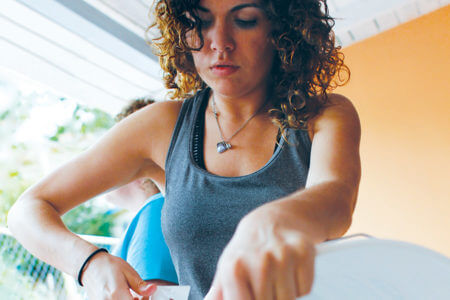
St. Mary’s senior Mei-Ling Camacho Acevedo assembles a water filtration system in Maricao, a mountainous area of Puerto Rico devastated by Hurricane Maria. Photo by Ricardo Arduengo.
Hurricane Maria swept over Puerto Rico with nearly Category-5 force on Sept. 20, 2017, a mere two weeks after Hurricane Irma made a damaging pass over the U.S. territory.
The strongest storm to hit the Caribbean island since 1932, Hurricane Maria did not just whip the island with rain and wind for more than 30 hours. It destroyed vital infrastructure and catastrophically damaged electrical, communications and water systems.
The St. Mary’s University community has dozens of students, staff and alumni who call Puerto Rico home, some of whom also have strong ties to a Marianist school there, Colegio San José.
And as they returned home before the Spring semester, they discovered how slow the progress toward recovery had been in the months since Maria hit. They heard heartbreaking tales from their loved ones of hardship, sickness, crime and death. And, in the St. Mary’s spirit of service, they found ways to help however they could.
“Our education is focused on helping and giving back to people in the community, not just getting a good education,” said Andrés Palacios, a junior Exercise and Sport Science major and Biology minor.
Palacios, a Colegio San José graduate, visited home in December and joined a group that included St. Mary’s staff, students and their families to help assemble 100 water filtration systems for those without drinkable water in a mountainous area of the island.
“People don’t just come to St. Mary’s and forget about the values when they leave,” Palacios said. “They keep using those values for the rest of their lives.”
Living with the aftermath
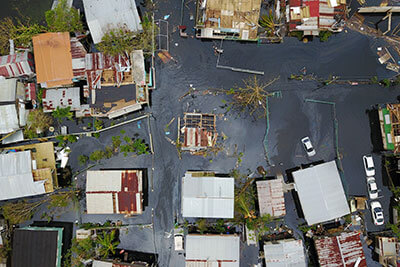
Floodwaters overwhelm the neighborhood of Juana Matos in Cataño, Puerto Rico, after Hurricane Maria inundated the island in September. Photo by Ricardo Arduengo.
Many of the threads that form the fabric of a civil society in Puerto Rico have frayed because of the length of the recovery.
In January, hundreds of thousands of people still did not have power. According to CNN, the Army Corps of Engineers estimated power would not be fully restored until May — about eight months after the storm.
Badly damaged roadways and the lack of electricity for streetlights contributed to a multitude of collisions, including one involving Palacios’ father. Lack of power left schools, businesses and courtrooms shuttered for months. In the meantime, those who could get their hands on a generator were spending hundreds of dollars a month on fuel, Palacios said.
St. Mary’s University Trustee Brother Reinaldo Berrios, S.M., who lives at the Marianist community at the all-boys Colegio San José and directs its financial aid program, said the school relied on a generator for several weeks to remain open. He added that repairs cost about $1 million. He anticipated students attending Colegio San José will require more financial aid for tuition because of the economic impact of the storm, but the school was unable to hold a planned scholarship fundraiser.
The lack of lighting, especially at night, combined with a spate of sick days by thousands of police officers protesting overdue overtime pay, may have contributed to an increase in crime on the island.
Mei-Ling Camacho Acevedo, a senior Marketing major, recounted a harrowing tale of her mother trying to get enough fuel to reach the airport to reunite with family in Tampa, Florida. As her mother waited overnight at a closed gas station in hopes of buying fuel when it reopened the next morning, someone tried to rob her at gunpoint. Camacho Acevedo said a police officer intervened and stopped the holdup.
Residents in fragile health have suffered too. Some struggled to keep diabetes medication refrigerated or receive chemotherapy for cancer. Camacho Acevedo said her family had to bring her uncle to Houston for cancer treatment he could no longer obtain on the island.
In December, while cleaning and repainting his mother’s home in Puerto Rico, Brother Jose Julian Matos-Auffant, S.M., Minister for Spiritual Development at St. Mary’s, said he learned of a young man who had a medical condition requiring him to remain on a ventilator. One night, the generator powering the ventilator ran out of diesel and the man died.
“I was not expecting all of the deaths that people told me about, even in my own neighborhood, that are not being related to the storm because these people were not blown away by the wind,” Matos-Auffant said. “People I had said hi to a year ago had died because of all of these complications. That, for me, was very shocking.”
Rattlers lend a hand

Brother Jose Julian Matos-Auffant, S.M., St. Mary’s Minister for Spiritual Development (from left); Rosalind Alderman, Ph.D., St. Mary’s Vice Provost for Enrollment Management; and St. Mary’s Trustee Brother Reinaldo Berrios, S.M., visit Colegio San José. Photo by Ricardo Arduengo.
Soon after the hurricane, Rosalind Alderman, Ph.D., St. Mary’s University Vice Provost for Enrollment Management; Matos-Auffant; and students from Puerto Rico gathered in the Contreras Student Lounge at St. Mary’s for prayer and support since they were unable to communicate with their families on the island. Alderman said the students wanted to help those back home. They ultimately raised several thousand dollars by selling Puerto Rican dinners at Casa Maria and by other means, which helped fund scholarships to Colegio San José students.
St. Mary’s is also planning to offer two new full-tuition scholarships next fall to graduates of Colegio San José, Alderman said.
“It’s not like these families are going to recover tomorrow. This would guarantee that we could help someone on a bigger level,” Alderman said of the scholarships, which will be awarded based on merit and financial need.
Alderman said the University also re-evaluated the financial aid packages of Puerto Rican students already enrolled, creating greater financial aid resources for some.
Matos-Auffant said he is considering service trips that St. Mary’s students could undertake to help Puerto Rico next academic year. In the meantime, St. Mary’s students at home over Christmas break helped neglected communities in the mountainous interior.
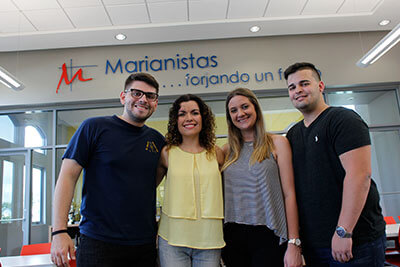
St. Mary’s students David Pagán (from left), Mei-Ling Camacho Acevedo, Paola Díaz Portela and Andrés Palacios meet over Christmas break inside Colegio San José. Photo by Ricardo Arduengo.
In an effort Alderman orchestrated in December, her family, Palacios, Camacho Acevedo, Matos-Auffant and others helped assemble rainwater filtration systems to provide drinkable water to remote communities in Maricao. They also wrapped hundreds of toys for area children to enjoy a Three Kings Day celebration and set up a generator at a church.
“The community we went to was completely forgotten. I opened my eyes to even more need,” Camacho Acevedo said. “To help put together something that is going to help with everyday living, it really was a step forward because we were getting our ‘hands dirty.’”
Palacios added that while it will take months longer for Puerto Rico to return to some semblance of normality, volunteering in the mountains “felt good, because I was doing something for a really underserved community that was being ignored by the local government.”
“Part of this test, this crisis, is to make sure that we embrace the students here and their families,” said Alderman, adding another part of the mission is to help students understand what has happened in Puerto Rico.
“We are part of the solution. We’re part of what needs to be done in this crisis,” Alderman said.


